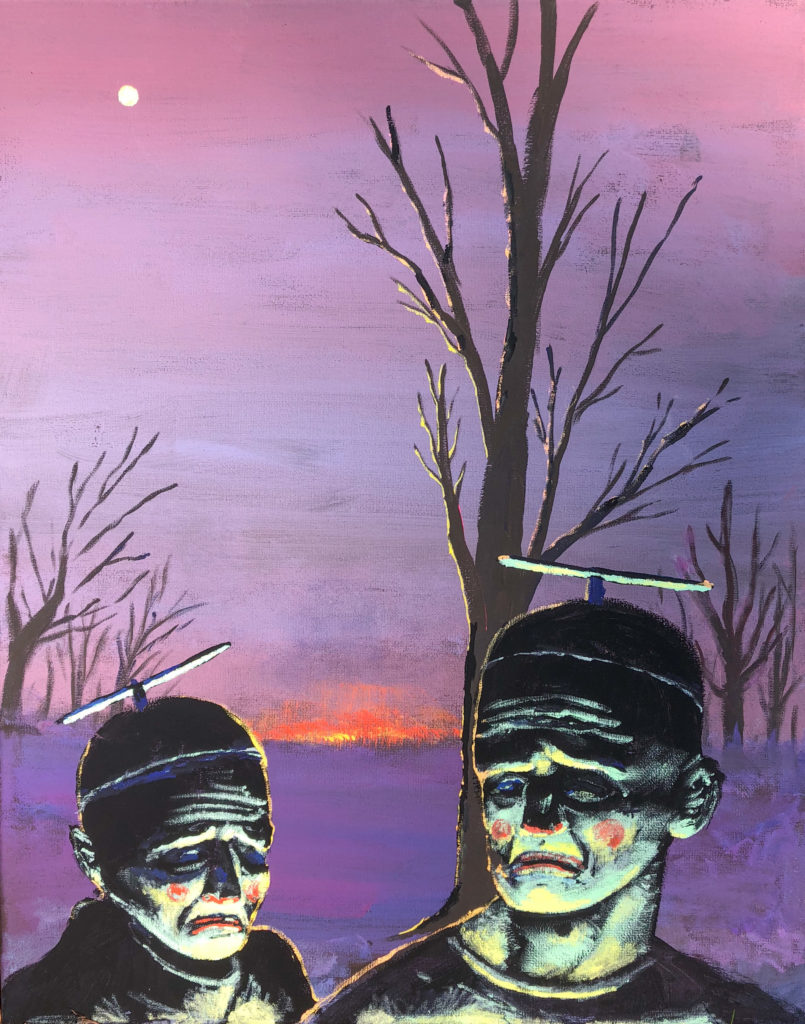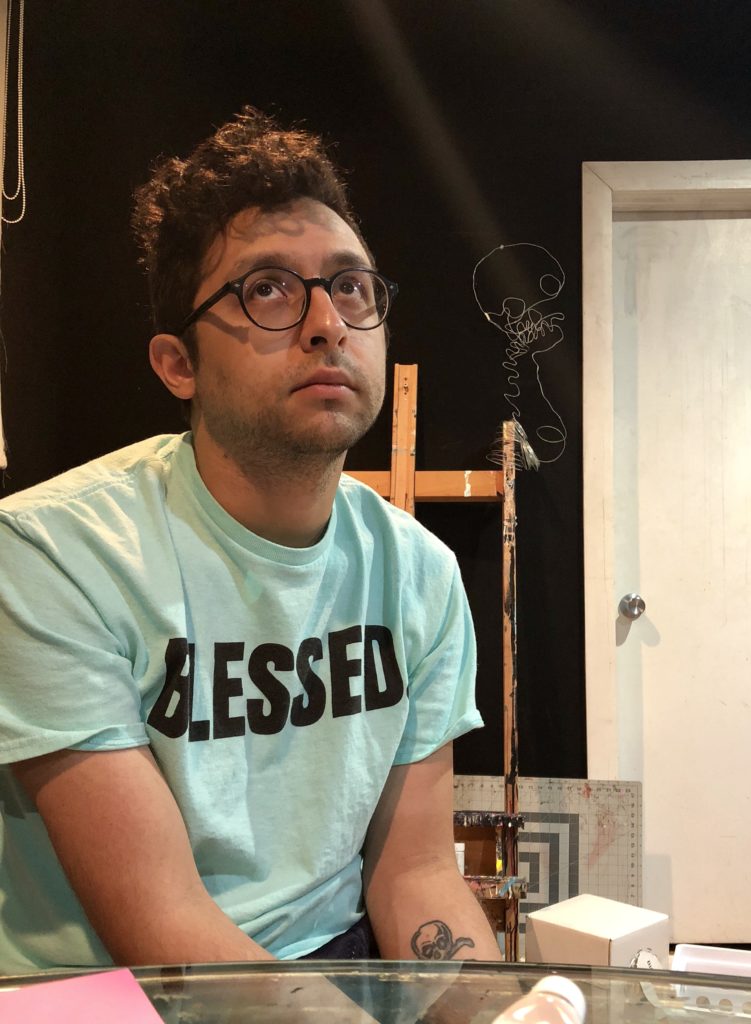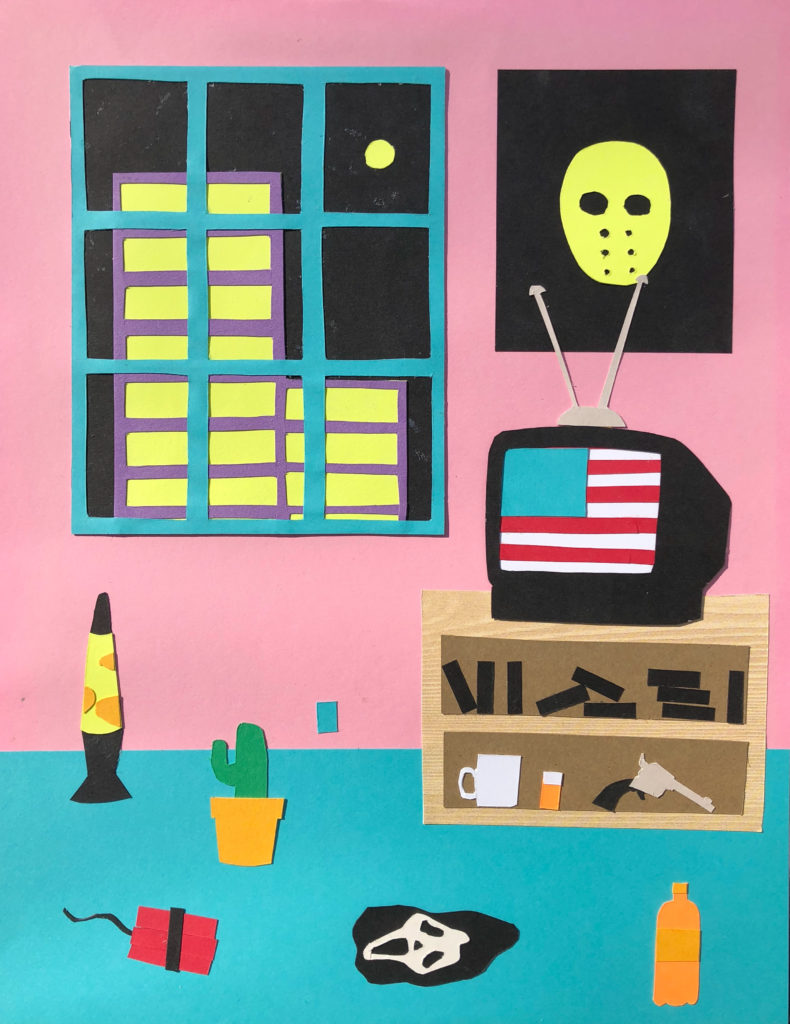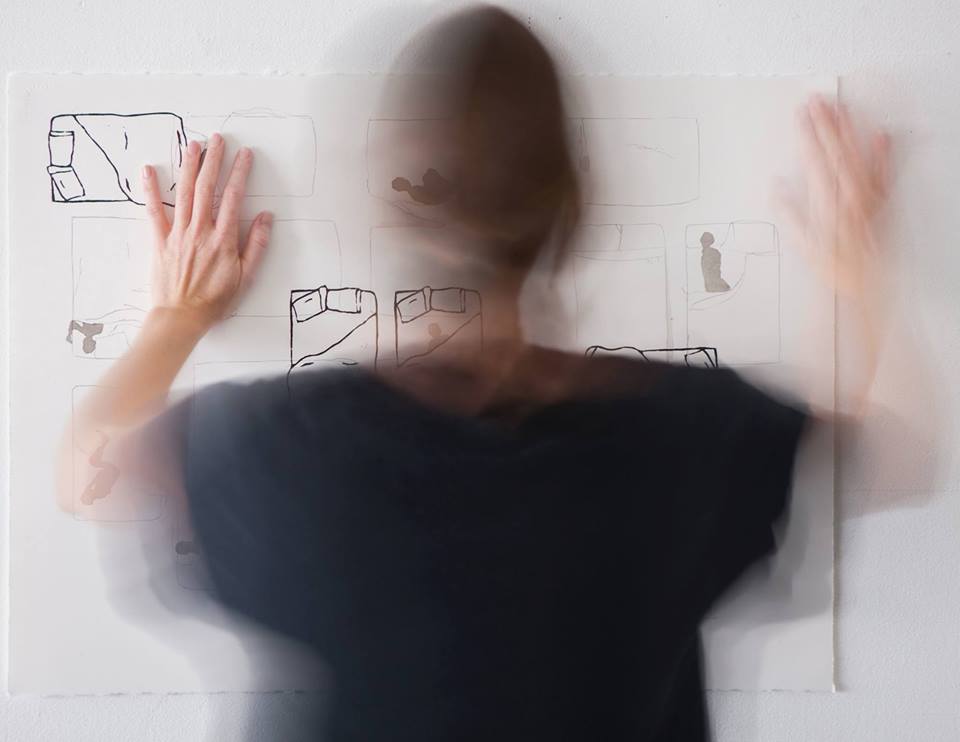Malls, technology, and waffle fries — these are the subjects that catch the eye of Mexican-American artist Andrew Muñoz. Facets of consumerism are often a theme in his drawings and paintings, as he finds inspiration in the endless psychological  attack of sounds, noises, and advertising we’re exposed to every day. In all the noise, he shares that he hopes to find clues about identity within the commercially-saturated American experience.
attack of sounds, noises, and advertising we’re exposed to every day. In all the noise, he shares that he hopes to find clues about identity within the commercially-saturated American experience.
Muñoz grew up in Marietta, just 20 miles from Downtown Atlanta, and graduated from SCAD-Atlanta in 2012. Since then, he’s made his way to his home studio in East Atlanta, where he draws and paints. While he’s working on growing his presence in Atlanta, he’s shown his work at Hi-Lo Press, Blue Mark Studios, and at his alma mater’s Open Studio Night so far, with plans for more in the months to come.
Here, Muñoz shares more about how his heritage influences his art, why he prefers observing over a collaboration, and why he makes art.
CommonCreativ: What sparked your interest in art? From where would people recognize your work?
Andrew Muñoz: I guess I’ve always been an artist in the sense that I’ve always been a little weird and drawing things. I wound up as a painting major because I initially felt kind of misplaced, even in art school, but I wound up meeting so many wonderfully odd people in the painting department that I decided to pursue that.
I’m not really consistent with getting my work out there, but recently I had a bunch of collages up at Hodge Podge during October and I made a lithograph print for the “Let’s Be Friends 2” group show at Hi-Lo Press, so that’s progress. I also had a bunch of different works scattered around SCAD’s Open Studio Night and the “This Is It” group show I co-curated at Blue Mark Studios.
CC: How does your Mexican-American heritage inform your art, if at all?
AM: I’m not sure. It’s something that’s always there, so it probably partially informs lots of things I do, even if I’m unaware of it. But it’s weird for me because my Spanish is lousy and I feel very Americanized, so sometimes I feel sandwiched in between cultures. This might have led to my work’s focus on culture and lifestyle.
 CC: Technology and consumerism show up in your work often. What triggered the usage of these themes?
CC: Technology and consumerism show up in your work often. What triggered the usage of these themes?
AM: As a teenager, I was a mallrat. I would buy coffee from the smaller-than-usual Starbucks, play with the expensive lightsabers at Sharper Image, buy oversized pizza slices at Sbarro’s, flip through the adult-themed blacklight posters at Spencer’s, and then go home feeling completely fulfilled because I craved that constant stimulation.
I’m an adult now and supposedly should know better, but I’m still a big fan of consumerism. These days if I feel bad, I just go to Target and wander the aisles for an hour. However, there’s a part of me that recognizes why the whole thing is a little sad and absurd, but I’m fine with that.
CC: A lot of the drawings in your food series are iconic “American” dishes, like the waffle fries. What inspired that?
AM: One day I started painting pizza slices and I would paint them just like you make them: first the dough, then the sauce, then cheese, etc. I picked pizza because it’s typical comfort food for broke young people and I was relating to that at the time. Then I started branching out and picking more foods that everyone was familiar with because food can hold these deep meanings and evoke old memories.
I felt if I could just successfully render a food item on a blank page, people would fill in the rest with their memories and associations. Using the waffle fries, for example, those remind me of the Chik-Fil-A down the street from my middle school, and then suddenly I’m flooded with all the awkward memories that stem from that. For others, it could represent any number of things because even just the image of food can evoke a multisensory response.
CC: What are your favorite materials to work with? Do you have any on your wish list?
AM: I usually paint with acryla-gouache, fast-drying, opaque acrylic-based watercolor paint, because it handles smoothly and can easily create large areas of consistent color. I’ve also been using cut paper a lot. That started a few years ago because I liked how it was childlike and had different visual demands than drawing or painting.
Every time I try to represent a real object with paper, I’m forced to reduce it down to its most basic shapes while still keeping it recognizable. I’ve also always liked just a pen and paper for drawing. As far as the future goes, I’ve actually been looking for a larger and more physical material to replicate what my cut paper pieces do, so hopefully, I find that soon.
CC: What’s your creative process?
AM: There are times when I simply feel like I need to get something out and then it manifests itself into a crude painting or drawing. I don’t really plan things or make sketches, I just like to throw myself into the process and sometimes it works and sometimes it definitely does not. After the initial inspiration, I’ll start to refine what I’m doing and then over the course of a body of work, I’ll keep developing that idea until I’m over it. Sometimes it lasts for just a few pieces. Sometimes it last months.
AM: I’m a bit of an art history nerd, so I like researching Robert Rauschenberg, and I have a deep affinity for Cézanne paintings. It’s probably pretty obvious, but I’m also a big fan of Pop Art and mining pop culture for material. I find inspiration in horror movies, surrealist themes, New Yorker cartoons, video games, and comics. When I work I like to have a movie playing in the background while I listen to music or podcasts. I just like the sensory overload. I’m also a big fan of nostalgia and navel-gazing. I get lost in my thoughts a lot.
CC: How do you promote yourself?
AM: I could be a lot better at this part. Typically, I post new work to my social media accounts and website, and then occasionally somebody inquires in my DMs. Other than that, I just frequently check my email and periodically submit work into juried shows and things like that. In all honesty, I should probably be asking the younger artists for advice — they seem to have a much stronger grasp of social media and branding.
CC: Do you have any dream collaborations with other local artists?
AM: I don’t really think of myself as much of a collaborator because if I really like an artist’s work, I would feel like I’m tainting their vision, but I would probably like to simply be an assistant to HENSE while he works on some colossal thing. I like his work a lot because it’s this intense modernist thing where he’s kind of playing visual jazz by alternating different colors and shapes, but it’s always adapting and turning into something new. It would be pretty cool to get a closer look at that process.
CC: What do you think about Atlanta’s current art scene?
AM: I’ve had the good fortune to have met lots of interesting and good-natured creative people in this city and there are usually lots of arts-related things to do here. There are also a few organizations here that work hard to support the arts. That being said, I think there’s a lot of potential for growth, and that’s probably why I stick around.
CC: Why do you make art?
AM: I make art as a way to cope and as a means to communicate the things I have trouble saying.
You can check out more of Andrew’s art on his portfolio site and Instagram.







